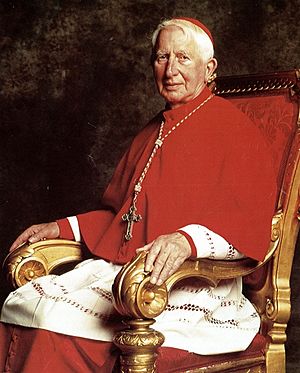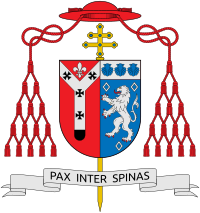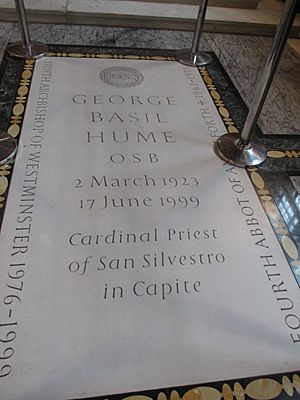Basil Hume facts for kids
Quick facts for kids His Eminence Basil Hume OSB OM |
|
|---|---|
| Cardinal, Archbishop of Westminster Primate of England and Wales |
|
 |
|
| Church | Roman Catholic Church |
| Province | Westminster |
| Appointed | 9 February 1976 |
| Enthroned | 25 March 1976 |
| Reign ended | 17 June 1999 |
| Predecessor | John Carmel Heenan |
| Successor | Cormac Murphy-O'Connor |
| Other posts | Cardinal Priest of San Silvestro in Capite |
| Orders | |
| Ordination | 23 July 1950 |
| Consecration | 26 March 1976 by Bruno Heim |
| Created Cardinal | 24 May 1976 |
| Rank | Cardinal priest |
| Personal details | |
| Birth name | George Haliburton Hume |
| Born | 2 March 1923 Newcastle upon Tyne, England |
| Died | 17 June 1999 (aged 76) London, England |
| Buried | Chapel of St Gregory and St Augustine, Westminster Cathedral, London |
| Nationality | British |
| Denomination | Roman Catholic |
| Parents |
|
| Previous post | Abbot of Saint Lawrence's Abbey, Ampleforth (1963–1976) |
| Coat of arms |  |

George Basil Haliburton Hume (2 March 1923 – 17 June 1999) was an important English Catholic leader. He was a monk and priest in the Benedictine monastery of Ampleforth Abbey. He served as its abbot (the head of the monastery) for 13 years. In 1976, he became the Archbishop of Westminster, which is a very high position in the Catholic Church in England and Wales. Later that same year, he was made a Cardinal.
From 1979, Cardinal Hume also led the group of Catholic bishops in England and Wales. He held these important roles until he passed away from cancer in 1999. He is buried at Westminster Cathedral in London. Many people, both Catholic and non-Catholic, respected him greatly. After his death, a statue of him was put up in his hometown of Newcastle upon Tyne. Queen Elizabeth II herself unveiled it.
Contents
Who Was Basil Hume?
His Early Life and Family
Basil Hume was born George Haliburton Hume on 2 March 1923, in Newcastle upon Tyne, England. His father, Sir William Errington Hume, was a doctor from Scotland and a Protestant. His mother, Marie Elizabeth Hume, was a French Catholic. Basil had three sisters and one brother.
His Schooling and Monastic Path
From ages 13 to 18, Hume attended Ampleforth College, an independent school. After finishing school in 1941, at 18, he joined the Benedictine monastery at Ampleforth Abbey in North Yorkshire. There, he took the monastic name Basil. He made his solemn promises as a monk in 1945.
After Ampleforth, Hume studied at St Benet's Hall, Oxford, which is a Benedictine college. He earned a degree in modern history. Since he couldn't study Catholic theology at Oxford back then, he went to the University of Fribourg in Switzerland. There, he completed his theology studies and earned a special degree in Sacred Theology.
Becoming a Priest and Abbot
Basil Hume became a priest on 23 July 1950. He then returned to Ampleforth Abbey to teach subjects like religious education, history, French, and German. He even led the school's Modern Languages Department. In 1963, he became the abbot of Ampleforth, leading the entire monastery.
Hume enjoyed staying active. He loved jogging and squash. He was also a big fan of the Newcastle United Football Club. He once said that getting an autograph from Jackie Milburn, a famous Newcastle United player, was one of his proudest moments!
Becoming Archbishop of Westminster
On 9 February 1976, Pope Paul VI chose Basil Hume to be the Archbishop of Westminster. This is the most senior Catholic leader in England and Wales. It was a bit of a surprise choice because Hume had mostly worked in a monastery and hadn't led a large diocese before. He was also the first monk to hold this position in over a century. When he heard the news during dinner, he later joked that he "did not enjoy the rest of the meal."
Hume officially became a bishop on 25 March 1976. Archbishop Bruno Heim performed the ceremony at Westminster Cathedral.
Life as a Cardinal
| Styles of Basil Hume |
|
|---|---|
 |
|
| Reference style | His Eminence |
| Spoken style | Your Eminence |
| Informal style | Cardinal |
Just a few months after becoming archbishop, on 24 May 1976, Pope Paul VI made Basil Hume a Cardinal. This is a very high rank in the Catholic Church. As a cardinal, he helped choose the next Pope in 1978, taking part in two special meetings called conclaves.
Even after becoming an archbishop, Hume always saw himself as a Benedictine monk first. He believed his duties were like those of a Benedictine abbot, who should "hate faults but love the brothers."
Cardinal Hume was known for trying to find a middle ground in his beliefs, pleasing both traditional and more modern thinkers. For example, he believed in the importance of love between people. He did not support women becoming priests, but he understood that many good people had different views on some church teachings.
During his time as Archbishop, the Catholic Church became much more accepted in British society. A big moment was in 1995 when Queen Elizabeth II visited Westminster Cathedral for the first time. This showed how much things had changed. Also, Pope John Paul II made a historic visit to England in 1982 while Hume was archbishop.
In 1998, Hume asked Pope John Paul II if he could retire. He wanted to go back to Ampleforth Abbey to live a quiet life, enjoy fly fishing, and follow his beloved Newcastle United Football Club. However, the Pope did not grant his request.
In April 1999, Cardinal Hume announced that he had terminal cancer. On 2 June of that year, Queen Elizabeth awarded him the Order of Merit, a very special honor. He passed away just over two weeks later, on 17 June, at the age of 76. His funeral service was shown live on national television, and he was buried in Westminster Cathedral. Pope John Paul II sent a message of sympathy, praising Hume as a "shepherd of great spiritual and moral character."
His Lasting Impact

Cardinal Hume was often named Britain's most popular religious figure in surveys. Many believed this was because he treated everyone with great kindness and respect, no matter their religion or background. His legacy lives on in several ways:
- A statue of Hume was put up in his hometown of Newcastle and unveiled by the Queen in 2002.
- The Cardinal Hume Centre in Westminster helps homeless young people, families, and others who are struggling.
- A beautiful flower, the Cardinal Hume Rose, is named after him.
- Cardinal Hume Catholic School in Gateshead, England, is named in his honor and teaches over 1,000 students.
- The Hume Theatre at St Mary's Catholic School, Bishop's Stortford, is named after him. He opened it a few years before he died.
- The Hume building at St. Mary's Menston school, opened in 2001, also bears his name.
- The Basil Hume Scholarship helps new students attend Ampleforth College.
Awards and Honors
National Awards
 United Kingdom: Order of Merit - a very high honor given by the British monarch.
United Kingdom: Order of Merit - a very high honor given by the British monarch.
Other Honors
- Member of the Athenaeum Club, London - a famous private club.
See also
 In Spanish: Basil Hume para niños
In Spanish: Basil Hume para niños

